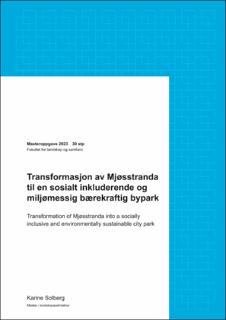| dc.contributor.advisor | Lei Gao | |
| dc.contributor.advisor | Ellen Merete Husaas | |
| dc.contributor.author | Solberg, Karine | |
| dc.date.accessioned | 2023-07-19T16:27:44Z | |
| dc.date.available | 2023-07-19T16:27:44Z | |
| dc.date.issued | 2023 | |
| dc.identifier | no.nmbu:wiseflow:6839561:54592107 | |
| dc.identifier.uri | https://hdl.handle.net/11250/3080260 | |
| dc.description.abstract | Prosjektområdet Mjøsstranda er lokalisert i Gjøvik sentrum ved Mjøsa. I dag preges byrommet av industri, parkeringsarealer og bilgenerende handel. Det er få funksjoner som inviterer til rekreasjon og opphold, med unntak av den populære turveien Mjøspromenaden. Det har lenge vært ønsker om å transformere Mjøsstranda til en ny bydel med handel, næring, rekreasjon og boliger. I forprosjektet i 2020 ble det oppdaget store mengder metangass i grunnen, i tillegg til forurensning med PAH og tungmetaller. Dette førte til nye forutsetninger for utviklingen av området. Denne oppgaven er en mulighetsstudie på hvordan Mjøsstranda kan transformeres. Det vil bli tatt tak i stedets fysiske utfordringer for å skape en sosialt inkluderende park med god tilgjengelighet til Mjøsa. I tråd med FNs bærekraftsmål nr. 11- Bærekraftige byer og lokalsamfunn, viser oppgaven en framtidsrettet løsning med mennesket i fokus.
Oppgaven bygger på teoretisk litteratur om sosial og miljømessig bærekraft. Sammen med medvirkning, registreringer og analyser dannet dette grunnlaget for utformingen av løsningsforslaget. Mulighetsstudien framstilles gjennom en overordnet plan, en hovedplan for Mjøsstranda og delområder. Disse vil vise hvordan Mjøsstranda kan transformeres til en attraktiv bypark til glede for nærområdet. Det vektlegges bruk av parken året rundt, flerfunksjonalitet og det sosiale. Nye møteplasser skal inkludere ulike brukergrupper og skape mangfold. Forslaget vil bidra til å styrke Gjøviks identitet. | |
| dc.description.abstract | The project area Mjøsstranda is located in the center of Gjøvik by the lake Mjøsa. Today, the urban space is characterized by industry, parking areas and car-generating trade. There are few functions for recreational purposes, with the exception of the popular hiking route Mjøspromenaden. There have long been wishes to transform Mjøsstranda into a new district with commerce, industry, recreation and housing. During the early stages of the project in 2020, large amounts of methane gas were discovered in the ground, as well as heavy metals and PAH. This led to new conditions for the development of the area. This master thesis is a feasibility study on how Mjøsstranda can be transformed. The site’s physical challenges will be handled in order to create a socially inclusive park with good accessibility to Mjøsa. In line with the UN’s sustainability goal 11- Sustainable cities and local communities, the landscape design
shows innovative solutions with people in focus.
The thesis is based on literature on social and environmental sustainability. Supported by participation, registrations and analyses, this creates the basis for the design. The feasibility study is prepared through an overall plan, a main plan for Mjøsstranda and sub-area plans. These will show how Mjøsstranda can transform into an attractive city park for the benefit of the local community. The main plan emphasize use of the park all seasons, multi-functionality and social arenas. New social meeting places include different user groups and create diversity. The proposal strengthens the identity of Gjøvik. | |
| dc.language | nob | |
| dc.publisher | Norwegian University of Life Sciences | |
| dc.title | Transformasjon av Mjøsstranda til en sosialt inkluderende og miljømessig bærekraftig bypark | |
| dc.type | Master thesis | |

